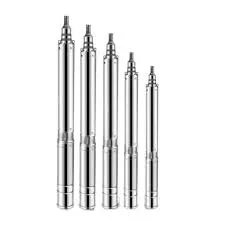Dec . 05, 2024 14:29 Back to list
deep well submersible pump check valve
Understanding Check Valves for Deep Well Submersible Pumps
Deep well submersible pumps are designed to extract water from deep underground sources, a vital task in agriculture, municipal water supply, and various industrial applications. A crucial component of these systems is the check valve, which plays an essential role in ensuring the efficiency and longevity of the pumping operation. This article will explore the significance of check valves in deep well submersible pump systems, their functionality, types, and the factors that influence their performance.
What is a Check Valve?
A check valve is a mechanical device that allows fluid (in this case, water) to flow in only one direction. It prevents backflow, which can not only lead to inefficiencies but also cause damage to the pump and related systems. In deep well submersible pumps, check valves are typically installed at the outlet of the pump or in the discharge pipe to maintain a continuous flow to the surface while preventing the water from flowing back into the well during power outages or pump stoppages.
Importance of Check Valves
1. Preventing Backflow The primary function of a check valve is to prevent backflow. Without this functionality, water could drain back into the well, causing the pump to lose its prime and potentially overheating or damaging the motor.
2. Enhancing Efficiency By preventing backflow, check valves maintain the pressure in the discharge line, ensuring that the pump operates efficiently. This efficiency not only conserves energy but also extends the lifespan of the pump.
3. Protection Against Water Hammer Water hammer is the sudden shock wave created when the flow of water is abruptly stopped. Check valves can help mitigate this phenomenon by allowing the fluid to reverse flow slowly, reducing stress on the piping system.
4. Reducing Maintenance Costs By preventing backflow and protecting the pump from potential damage, check valves can significantly reduce the need for maintenance and replacement parts, ultimately saving costs.
Types of Check Valves for Submersible Pumps
Check valves come in various designs, each suitable for different applications. Here are some common types used in deep well submersible systems
1. Swing Check Valve This type features a disc that swings on a hinge to allow flow in one direction. It is simple and effective but may not be suitable for all pumping scenarios, especially where low flow rates occur.
deep well submersible pump check valve

3. Ball Check Valve This valve uses a ball to block flow in the reverse direction. It is highly effective for smaller pipes and can be sensitive to changes in pressure.
4. Diaphragm Check Valve Utilizing a flexible membrane, these valves are excellent for preventing backflow in environments with significant pressure swings and are commonly used in applications where portability and lightweight designs are preferred.
Factors Influencing Check Valve Performance
Several factors can influence the performance and effectiveness of check valves in a deep well submersible pump system
1. Material Selection The material from which the check valve is made must be compatible with the fluid being pumped and resistant to corrosion.
2. Size and Rating The size of the check valve needs to match the discharge pipe to prevent flow restrictions, while the pressure rating should align with the operational conditions of the pumping system.
3. Installation Position Proper installation is critical to ensure that check valves function as intended. They should be installed vertically or horizontally according to the manufacturer’s guidelines, with adequate access for maintenance.
4. Maintenance and Inspection Regular maintenance and periodic inspection of check valves are crucial to ensure their reliable operation, particularly in harsh conditions.
Conclusion
Check valves are an indispensable component of deep well submersible pumps, serving to enhance efficiency, protect against backflow, and reduce maintenance costs. Understanding the types, functionality, and factors affecting their performance will aid in selecting the appropriate check valve for specific applications. Ultimately, investing in the right check valve helps ensure the long-term success and reliability of water extraction systems.
-
Submersible Water Pump: The Efficient 'Power Pioneer' of the Underwater World
NewsJul.01,2025
-
Submersible Pond Pump: The Hidden Guardian of Water Landscape Ecology
NewsJul.01,2025
-
Stainless Well Pump: A Reliable and Durable Pumping Main Force
NewsJul.01,2025
-
Stainless Steel Submersible Pump: An Efficient and Versatile Tool for Underwater Operations
NewsJul.01,2025
-
Deep Well Submersible Pump: An Efficient 'Sucker' of Groundwater Sources
NewsJul.01,2025
-
Deep Water Well Pump: An Efficient 'Sucker' of Groundwater Sources
NewsJul.01,2025
-
 Submersible Water Pump: The Efficient 'Power Pioneer' of the Underwater WorldIn the field of hydraulic equipment, the Submersible Water Pump has become the core equipment for underwater operations and water resource transportation due to its unique design and excellent performance.Detail
Submersible Water Pump: The Efficient 'Power Pioneer' of the Underwater WorldIn the field of hydraulic equipment, the Submersible Water Pump has become the core equipment for underwater operations and water resource transportation due to its unique design and excellent performance.Detail -
 Submersible Pond Pump: The Hidden Guardian of Water Landscape EcologyIn courtyard landscapes, ecological ponds, and even small-scale water conservancy projects, there is a silent yet indispensable equipment - the Submersible Pond Pump.Detail
Submersible Pond Pump: The Hidden Guardian of Water Landscape EcologyIn courtyard landscapes, ecological ponds, and even small-scale water conservancy projects, there is a silent yet indispensable equipment - the Submersible Pond Pump.Detail -
 Stainless Well Pump: A Reliable and Durable Pumping Main ForceIn the field of water resource transportation, Stainless Well Pump has become the core equipment for various pumping scenarios with its excellent performance and reliable quality.Detail
Stainless Well Pump: A Reliable and Durable Pumping Main ForceIn the field of water resource transportation, Stainless Well Pump has become the core equipment for various pumping scenarios with its excellent performance and reliable quality.Detail
